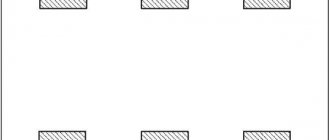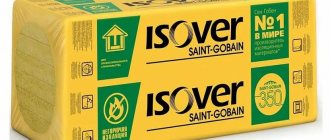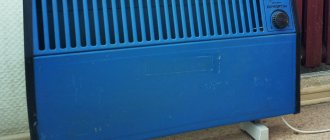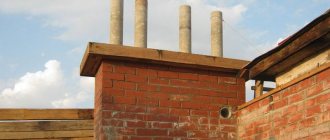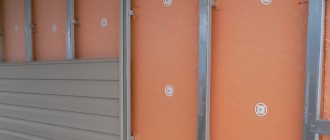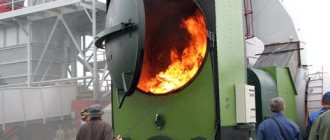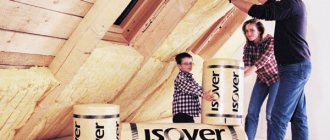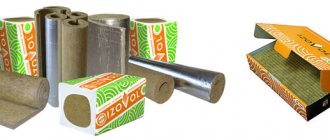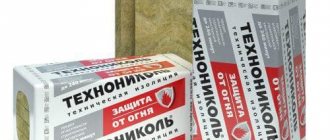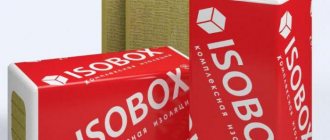Choosing insulation is not the easiest task. Some of them are afraid of getting wet (stone wool), others are difficult to work with (glass wool), and others have not yet found widespread use (foam glass). What remains is polystyrene foam. He is criticized for being unnatural and flammable, but in terms of technical characteristics, he is among the leaders. Moreover, extruded polystyrene foam (EPS), although more expensive, can withstand mechanical loads better than regular foam. One of the manufacturers, Penoplex, produces EPS of various densities and purposes. Its products are quite popular - it is one of the most famous brands in the country.
What is Penoplex and its scope of use
Penoplex (sometimes written “Penoplex”) is a thermal insulation material produced by the company of the same name.
is a large Russian manufacturer of construction and decorative finishing materials based on polymers. The company began its activities in 1998 with the launch of the first production line in Russia for the production of thermal insulation materials from extruded polystyrene foam under the PENOPLEX® brand.
produces extruded polystyrene foam (EPS or XPS). This material is used as insulation. It differs from its cheaper analogue - foamed polystyrene (foam plastic, EPS or PPS) in its greater density, due to which it better withstands mechanical loads. Another distinctive feature is lower vapor permeability. Or rather, it produces almost no steam. And the main trump card is the best thermal characteristics. Penoplex 20 mm thick in terms of heat retention is equivalent to almost double the thickness of mineral wool and 37 cm of brickwork.
Penoplex is one of the most effective thermal insulation materials
These characteristics determine the area of use of Penoplex. It is recommended for insulating areas where resistance to stress is important, and low vapor permeability is one of the requirements. More specifically, it is recommended to use Penoplex:
- For floor insulation: under the screed, on it, as an intermediate layer;
- when installing a floor on joists (with some reservations);
- thermal insulation layer under a heated floor (water or electric).
Another area of use is thermal insulation of facades or interior walls. But here you need to understand that due to the fact that Penoplex practically does not conduct moisture, additional measures will be needed to ensure that vapors do not get inside the wall. In addition, a well-thought-out ventilation system is needed to normalize the humidity in the house. And, in addition, you need to select the thickness of the insulation so that the dew point is inside the insulation, but not in the wall.
Optimally - insulation of a recessed base
If you prefer “breathable” walls and natural humidity regulation, Penoplex is not suitable for wall insulation in this case. It does not fit under ventilated facades either. The exact task there is to remove moisture from the insulation due to the movement of air in the ventilation gap. This material is not able to provide this, since moisture simply does not get inside Penoplex.
Domestic analogues of the material
Russian manufacturers have also launched the production of extruded polystyrene foam.
There are two analogues on the market: Technoplex and Polyspen. Each brand has its own characteristics.
Technoplex
Strength and thermal conductivity indicators are the distinctive features of Technoplex slabs. The manufacturer managed to achieve outstanding technical performance through the use of nanotechnology in the manufacture of insulation. The method involves adding graphite particles to help increase the density of the material. The heat insulator is used in private construction, as well as when installing a heated floor system. Unlike penoplex, technoplex is not orange, but light silver. The insulation produced varies in thickness. The plates are equipped with a special edge that simplifies installation. After fastening, finishing should be done as quickly as possible to protect the heat insulator from atmospheric influences.
Polyspen
Extruded polystyrene foam from Polyspen LLC is manufactured in three types, which differ in technical characteristics and scope of application:
- Polyspan Standard. They are used for foundation insulation, as well as for floor insulation.
- Polyspen 35 is indispensable for insulating building envelopes.
- Polyfoam 45 with the greatest strength is used in road construction, since it can even withstand the weight of an airplane. It is recommended to use it for thermal insulation of structures subject to heavy loads.
Polyfoam slabs of different sizes and thicknesses are available on the market; therefore, the density of the material also differs.
Types, characteristics, properties
Penoplex is available in several categories:
- Comfort. For insulation of walls, balconies, loggias.
- Foundation.
- Pitched roof.
- Wall.
Types and purpose of Penoplex insulation
As you can see, the manufacturer clearly delineates the areas of application of the material. With the general technology, they differ in density. The densest ones are for the foundation and floor, since they must withstand considerable loads for a long time. The manufacturer claims that the service life of Penoplex Foundation is up to 50 years.
Design differences
Some of the types of Penoplex have structural differences:
- Penoplex Wall slabs have a rough surface; stripes are applied to the surface of the slab using a router. All this improves adhesion to the wall and/or finishing materials.
- Penoplex Comfort is distinguished by an L-shaped edge, which during installation guarantees the absence of through seams.
- Penoplex Roofing has a U-shaped edge, which increases the reliability of the connection.
You can distinguish by external signs
. This is what concerns external differences. Next, let's look at the technical specifications. First, let's pay attention to what is common to all types, then to what distinguishes them.
General characteristics
Since the production technology of all types of Penoplex is similar, they have many of the same characteristics:
- Water absorption is very low: when immersed in water for a day, no more than 0.4% of the volume;
- when immersed for 28 days, 0.5% of the volume.
Flammability is not the best characteristic
Penoplex insulation boards are available in different thicknesses and densities
As you can see, according to temperature indicators, any type of Penoplex can be used in any part of the country - from the south to the north. Moreover, if you leave it to “winter” unprotected, nothing will happen to the material. This is not the merit of Penoplex, but a general property of extruded polystyrene foam.
What distinguishes different types
The manufacturer divided the types of Penoplex into areas of use. Their properties are optimal for a specific application. For example, the increased density of EPS required for a screed will not be needed when installing it on a plinth. Taking into account the fact that the price differs significantly, it makes no sense to use the “Foundation” brand for other purposes. But the difference in locks, with other characteristics being equal, can be neglected. Here we are talking about ease of installation. Although, this is also important.
| Parameter | Comfort | Foundation | Roof | Wall |
| Density | from 20 kg/m3 | 27-35 kg/m3 | 26-34 kg/m3 | from 20 kg/m3 |
| Elastic modulus | 15 MPa | 17 MPa | 17 MPa | 15 MPa |
| Thickness | 20, 30, 40, 50, 100 mm | 50, 100 mm | 100 mm | 50 mm |
| Static bending strength | 0.25 MPa | 0.4 MPa | 0.4 MPa | 0.25 MPa |
As can be seen from the table, Penoplex for foundations and roofs is denser, stronger, and better able to withstand bending loads. Designed for walls and the “Comfort” brand are less durable, since their area of application does not require resistance to mechanical stress.
Dimensions of standard sheet material
The manufacturer produces penoplex in two size categories:
- 1185×585 mm.
- 2370×585 mm.
The thickness is: 20 ; thirty ; 40 ; 50 ; 60 ; 80 ; 100 ; 120 ; 150 mm .
Read about the dimensions and characteristics of other types of material here >>>
Low vapor permeability - good or evil?
As you know, the same property of a material can be considered a plus in one situation and a minus in another. This is exactly the case with the low vapor conductivity that extruded polystyrene foam is characterized by. Moreover, it does not conduct steam in any direction. Moisture does not penetrate from one side or the other. This distinguishes it from vapor barrier membranes, which may have one-way conductivity.
It is ideal on flat roofs
Where is vapor non-conductivity needed?
If installed correctly (without gaps and cracks) with joints taped, EPPS does not require the use of vapor barrier membranes. It hardly lets through steam. Neither in liquid nor in gaseous state. So the use of membranes and waterproofing is unnecessary. When using floors in a cake, this is excellent, because moisture usually comes from the ground. When using polystyrene foam, it does not penetrate either by capillary action or in the form of steam. In this case, this is definitely a plus.
Excellent for laying under screed
These properties are also a plus when using extruded polystyrene foam in blind areas, under paths, etc. In addition to protecting against freezing, it does not get wet. This allows, with a competent approach, to get rid of frost heaving and make, for example, not a deep strip foundation, but a shallow strip or Swedish slab.
The use of EPS in the roofing pie of a flat roof is also optimal - leaks are minimized, and almost no heat is lost. When using on pitched roofs, it’s already worth thinking about. The fact that Penoplex Roofing does not allow moisture into the attic space is good. But it will be possible to remove excess moisture from the attic only with the help of very good ventilation, which includes not only dormer windows. Additional elements will be needed on the ridge, in the roof plane. In general, given the cost of Penoplex, this is not always reasonable.
On the walls: yes or no?
Insulating walls with Penoplex is permissible only if you agree to make an effective ventilation system that will regulate the humidity in the house. In this case there are two options:
- Insulate the walls with EPS from the inside. With this solution, moisture practically does not enter the enclosing structures (the material from which the walls are made) due to the low vapor permeability of the material. In this case, the Penoplex layer for walls can be of small thickness. Specifically, it is necessary to count, since it depends on the material and thickness of the walls, and the region of residence. But, with such insulation, it is necessary to select the external finishing of the facade so that moisture is not trapped inside the wall. Ventilated facades are most suitable for this purpose.
Installation on walls is possible, but with a lot of conditions. And this is not the best choice - Stick the EPS on the outside. But at the same time, it is necessary to make an effective vapor barrier inside the room. It is needed to prevent moisture from entering the walls. Since there is EPS on the outside, it will not come out. To prevent moisture from accumulating in the wall, a vapor barrier is required. In this case, the thickness of Penoplex will be large. So large that the dew point is not in the wall, but in the thickness of the insulation. That is, in this case it will be necessary to insulate EPS walls with a thickness of 100 mm or more.
As you can see, there are options for using extruded polystyrene foam for wall insulation, but they are far from the best. Despite the fact that the material itself is good, it is poorly suited for this purpose.
When used on a pitched roof
And we must also take into account that the second option is only for non-hygroscopic materials. Such a scheme is very undesirable for wooden, frame buildings; it is poorly suited for foam blocks. The fact is that no matter how good the vapor barrier is, some of the moisture will still get into the walls. If the material is non-hygroscopic, moisture will gradually be removed from the wall during the dry season. With hygroscopic materials this process is more complicated. As a result, the wood rots and the foam block walls “bloom.”
Advantages and disadvantages
Advantages of insulation:
- Good thermal insulation properties.
- Low vapor permeability.
- Almost zero water absorption according to GOST 15 588−86. The material does not absorb moisture and evaporation, so it can be used to insulate baths and saunas.
- High strength. Penoplex can withstand significant tensile and compressive loads.
- Good sound insulation.
- The service life of the material is up to 50 years, during which the insulation retains all its properties and original shape.
- Even with a long service life, the material retains its chemical structure and does not decompose into toxic components, thereby not causing harm to humans and the environment.
- Biological resistance. Penoplex Base is not susceptible to rotting and mold.
- Easy to cut and install. The material can be cut well with a paint knife and does not require the use of special tools for working with sheets.
- You can insulate your home with Penoplex Base at any temperature at home or outside.
- Light weight material.
Disadvantages of penoplex Base:
- Unnatural origin.
- High price.
- Strong smoke.
Dimensions and weight, quantity calculation
Penoflex thermal insulation boards can be of different thicknesses, so the packaging can have different sizes and contain a different number of sheets. It is also necessary to take into account that the dimensions of the slabs are indicated without taking into account the tenons/locks.
| Name and thickness | Dimensions (L/W) | Amount in a package | Insulation area per package | Packaging volume |
| Comfort 20 mm | 585*1185 mm | 18 pcs | 12.48 m2 | 0.273 m3 |
| Comfort 30 mm | 585*1185 mm | 12 pcs | 8.32 m2 | 0.2704 m3 |
| Comfort 40 mm | 585*1185 mm | 9 pcs | 6.24 m2 | 0.2493 m3 |
| Comfort 50 mm | 585*1185 mm | 7 pcs | 7.69 m2 | 0.2429 m3 |
| Comfort 100 mm | 585*1185 mm | 4 things | 2.77 m2 | 0.2772 m3 |
| Foundation 50 mm | 585*1185 mm | 7 pcs | 7.69 m2 | 0.2429 m3 |
| Foundation 100 mm | 585*1185 mm | 4 things | 2.77 m2 | 0.2772 m3 |
| Pitched roof 100 mm | 585*1185 mm | 4 things | 2.77 m2 | 0.2772 m3 |
| Wall 50 mm | 585*1185 mm | 8 pcs | 5.55 m2 | 0.2776 m3 |
There are two methods for calculating the number of packages: using the volume or area of the package:
- You know the insulated area, find the area of the insulation of the required thickness in the package and divide the insulated area by this value. For example, you need to insulate 15 squares; you will use slabs 40 mm thick. The insulation area in the package is 6.24 m². We count: 15/6.24 = 2.4 packs.
- To calculate by volume, multiply the insulated area by the thickness to obtain the required volume. Next, by analogy with the example above, we divide the found figure by the volume of one package. We get the number of packages of insulation. Let's calculate for the same case: 15 m² * 0.04 m = 0.6 m³. According to the table, one package of this material has a volume of 0.2493 m³. we find the number of packages: 0.6/0.2493 = 2.4 packages.
Penoplex for blind areas around the house and insulation of the basement is an excellent choice.
If the number of packages is not the whole number (most likely it will be), some surplus will form. If the surplus turns out to be large (as in the example - more than half of the slabs turn out to be unnecessary) and you have nowhere to use it, check to see if the seller sells incomplete packages. In this case, the calculation will be a little more complicated. You should estimate how many slabs you need in addition to the whole packages. For this:
- Find the area covered by entire packages. For example, this is: 2 packs * 6.24 m² = 12.48 m².
- Since we need to insulate 15 squares, we subtract the found one from this figure: 15 m² - 12.48 m² = 2.52 m². This is the area for which additional slabs should be purchased.
- The area of one Penoflex thermal insulation board is 0.6932 m². If we divide the remainder by this figure, we get the required number of additional insulation sheets: 2.52 m² / 0.6932 m² = 3.63 pcs. It turns out that we will need 4 slabs in addition to the two packages.
Depending on the thickness, the package contains from 4 to 18 pieces
. With such an accurate calculation, it is better to take a small supply - one or two slabs. In case there was a mistake somewhere in measurements or calculations, somewhere the edges became wrinkled and other unforeseen cases.
Technical characteristics of penoplex Base
Main technical characteristics of penoplex Base:
- The thermal conductivity coefficient is 0.030 W/(m*C), according to GOST 7076−99.
- The vapor permeability coefficient varies from 0.007 to 0.008 mg/(m*hour*Pa).
- The sound absorption of Penoplex Basis is 41 dB.
- Moisture absorption coefficient - 0.5−0.6%.
- The density of penoplex is from 28 to 35 kg/m³.
- Compressive strength - 0.20 MPa.
- Operating temperature range from – 100 to +75 °C.
- Fire resistance category - group G4.
Table 1. Comparison of the characteristics of various materials used for insulation
| Options | Penoplex Base | EPPS | Styrofoam | teaching staff |
| Thermal conductivity coefficient, W/(m*C) | 0,030 | 0,039−0,034 | 0,033−0,050 | 0,032−0,044 |
| Vapor permeability coefficient, mg/(m*hour*Pa) | 0,007−0,008 | 0,01 | 0,05−0,23 | 0 |
| Density, kg/m³ | 28−35 | 25−38 | 15−35 | 11−35 |
| Moisture absorption,% | 0,5−0,6 | 0,04 | 2−4 | 4 |
| Sound absorption | good | good | good | good |
The table shows that Osnova penoplex is not only not inferior to other polystyrene foam insulation materials, but even surpasses them in some indicators. The material has one of the lowest moisture absorption coefficients and retains heat well.
Installation technology
When laying on horizontal surfaces - floors, flat roofs - the slabs are simply laid on a flat surface. The surface should be without sharp changes, the maximum deviation is 2-3%. This requirement must be met so that voids do not form. When laying, we monitor the joints; it is advisable to glue them (you can use tape) or fill them with the same foam/glue on which the slabs are attached.
When using Foam plastic for insulation of balconies
If two layers of thermal insulation are laid, it is positioned so that the EPS slabs of the second row overlap the seams of the lower one. They also say that the slabs are laid with alternating seams or “staggered”.
When mounting on vertical surfaces, double fastening is used:
- Glue or adhesive foam is applied to the plane.
- Additionally fixed with umbrella dowels.
According to the technology for installing slab insulation on facades, umbrella dowels are installed at the junction of two sheets (any two sheets) and two additional fasteners in the plane of the sheet. That is, there are at least 8 fasteners per sheet (indicated in red in the figure). More is possible. Less - no. Unless, of course, you want the insulation and finishing to come off. If the winds in the region are strong, it is better to put more. To insulate the inside, you can install less (see diagrams below).
Schemes for installing umbrella dowels when installing Penoplex on vertical surfaces
During installation, on the outer slabs and around openings, we install fasteners more often: three to four elements per slab. To keep the insulation rigid in the corners of the openings, a mesh is attached to it before plastering. It is attached at an angle of about 45°, securing the joint. Under such conditions, there will be no problems with finishing inside or outside.
If plaster, facade tiles, finishing stone and other heavy materials are subsequently applied to Penoplex, before installation, care must be taken to improve the adhesion of the material to the wall and to the finish. Even if you are installing a Penoplex Wall with stripes, it is better to add roughness to the slab using a metal brush. And from both sides. If the wall is smooth, it also doesn’t hurt to add roughness - for better adhesion.
If the wall is smooth, it also needs to be processed by putting a metal attachment on the drill
To work with Penoplex, a special adhesive mixture is recommended: Ceresit ST 84, illbruck PU 010, Titan 753, Ceresit CT-85, Kreisel 210 and 220, Baumit ProContact, STO Baukleber, Soudal Soudabond, Penosil Fix and Go, Den Braven, Krass.
Application and types of penoplex
Considering that penoplex has a number of advantages, its scope of application is quite extensive. EPS serves as an excellent insulation material both indoors and outdoors. It is perfect for apartments, houses, cottages and other buildings. Penoplex can be used to insulate roofs, attics, and balconies, in any climatic region without the use of an additional moisture-proof layer. Since the material practically does not absorb water, it is quite possible to use it in an environment with high humidity. At the same time, its thermal conductivity remains almost unchanged. EPS sheets of various thicknesses are available for sale, and depending on the specific requirements, you can always choose the best option.
In addition to a variety of sizes, extruded polystyrene foam is available in several types depending on density and application. Let's look at each type:
- Penoplex Wall. The old name is Penoplex 31 with flame retardants . This material has a density of 25-32 kg/m³ and is intended for effective insulation of external and internal walls, partitions, and plinths. These slabs are also used in the construction of buildings when constructing walls using “well masonry”. Compared to traditional brick walls, such walls are much thinner, but are not inferior to them either in reliability or in the ability to retain heat. In case of insulation of external walls with penoplex, a plaster system can be made on top of the insulation using a mesh, or it can be lined with any façade cladding material (siding, tiles, lining).
- Penoplex Foundation. The old name is Penoplex 35 without fire retardant . This material has a density of 29-33 kg/m³ and has high thermal insulation characteristics, a minimum coefficient of water absorption and resistance to chemical and biological destructive factors. Its water-repellent ability allows it to be used as a waterproofing coating. Penoplex Foundation is a rigid slab with a stepped edge, used in the construction of basements, foundations, and insulation of septic tanks. The slabs are very durable and can withstand significant loads. Therefore, they can also be used as a basis for garden paths, plinths, and floors.
- Penoplex Roofing. The old name is Penoplex 35. This material has a density of 28-33 kg/m³ and well insulates the building from cold air, has minimal water absorption, the ability to insulate noise well, and has a long service life. The slabs have a standard size of 600x1200 mm, but if necessary they can be easily cut with any available tool. And the light weight of the slabs allows them to be used without reinforcing roof structures. The stepped edge located along the perimeter acts as an additional guarantee that “cold bridges” will not form at the joints of the slabs. This type of penoplex can be used to insulate any type of roof. However, more often this insulation is used for insulating flat roofs, as well as for insulating the attic space of a ventilated roof.
- Penoplex Comfort. The old name is Penoplex 31C. This material has a density of 25-35 kg/m³ and has an extremely low thermal conductivity coefficient, high hydrophobicity, and excellent ability to insulate noise. It does not rot and is not a favorable environment for the settlement of insects, mold and fungi. Penoplex Comfort is produced in the form of slabs measuring 600x1200 mm, which have a step-shaped edge along the perimeter. It serves as an additional guarantee of accurate installation. Being a kind of universal, this insulation is simply ideal for thermal insulation of a private house. They can be used to insulate floors, foundations, basements, roofs and walls.
This material has a density of 35-47 kg/m³ and is used as insulation for road surfaces, in particular runways, to prevent them from frost heaving of the soil and destruction of the top layer of the road surface. It is also widely used for insulating roofs in use, on which there are pedestrian areas and various areas, including parking lots.
Penoplex 45.
Advantages and disadvantages
The positive features of insulation are manifested at all stages of use of this material:
- Lightweight slabs are easy to prepare and process and do not require special knowledge and skills to operate.
- They are attached in different ways and do not require additional layers of vapor and waterproofing.
- Excellent thermal insulation qualities allow you to save on other building materials.
- Durability and strength in any climate tests.
- Safety and environmental friendliness.
The disadvantages of the new generation material include:
- Susceptibility to attacks by rodents , which is typical for all types of insulation.
- Emission of acrid smoke when decomposed by open fire.
- Does not withstand combination with kerosene , gasoline or diesel fuel.
- Insufficient sound insulation compared to materials intended for this purpose.
- High prices for various types of penoplex, comparable to expensive mineral wool.
Types of insulation boards
We insulate the floor on the balcony
Since there are plenty of varieties of penoplex on the construction market, manufacturers produce it with specific names that allow you to speed up the selection process. Let's look at these types:
- Penoplex “roofing” - the density of roof insulation slabs is 28-33 kg/m3. Lightweight and waterproof
- “Wall” - can be used for both interior and exterior work. The density of the material is 25-33kg/m3
- “Foundation” - high density and water resistance allows the material to be used during the construction of a foundation or basement. Density – 29-33kg/m3
- “Comfort” - slabs are used for balconies and apartments, as well as uninsulated loggias. Density – 25-35kg/m3
- Penoplex “45” - this material has the highest density among others, which is 35-47 kg/m2. This is why it is used during the construction of roads and runways.
For the average consumer, I have compiled a table of the estimated cost of penoplex. Thanks to it, you can make approximate calculations of the required amount to purchase material of different thicknesses:
| Name | Thickness | Area/volume per package. m2/m3 | Sheets per package (quantity) | Cost of 1 package | Price for 1 sheet |
| PENOPLEX | 20 | 14,4/0,288 | 20 | 1 200 — 1 400 | 60-70 |
| 30 | 10,08/0,30 | 14 | 1 260 — 1 540 | 90-110 | |
| 40 | 7,2/0,288 | 10 | 1 200 — 1 400 | 120-140 | |
| 50 | 5,76/0,288 | 8 | 1 200 — 1 520 | 150-190 | |
| 60 | 5,04/0,30 | 7 | 1 260 – 1 274 | 180-182 | |
| 80 | 3,6/0,288 | 5 | 1 195 – 1 205 | 239-241 | |
| 100 | 2,88/0,288 | 4 | 1 200 – 1 240 | 300-310 |
MAIN LINE OF PRODUCTS PENOPLEX plant:
- PENOPLEX ROOF – used for thermal insulation of pitched and flat roofs;
- PENOPLEX WALL - used for thermal insulation of external and internal enclosing structures (walls, plinths, partitions, facade systems);
- PENOPLEX FOUNDATION - used in loaded structures with a protective layer (cement-sand screeds, foundations, floors);
- PENOPLEX COMFORT - used for thermal insulation of country houses or city apartments (insulation of walls, extensions, balconies, loggias).
